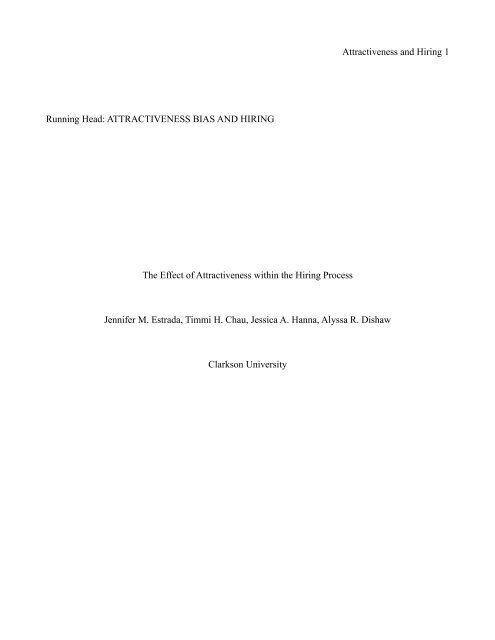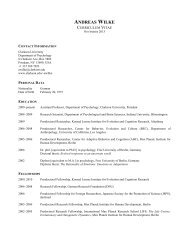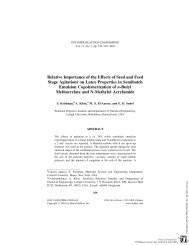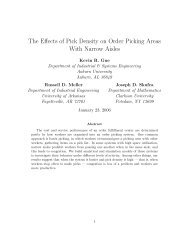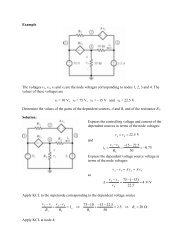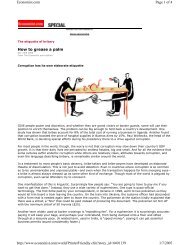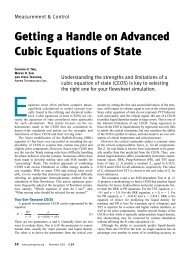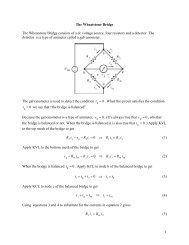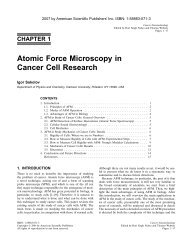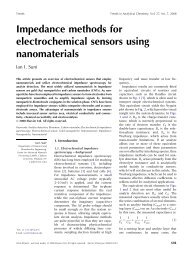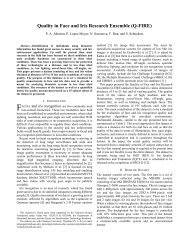ATTRACTIVENESS BIAS - Clarkson University
ATTRACTIVENESS BIAS - Clarkson University
ATTRACTIVENESS BIAS - Clarkson University
Create successful ePaper yourself
Turn your PDF publications into a flip-book with our unique Google optimized e-Paper software.
Running Head: <strong>ATTRACTIVENESS</strong> <strong>BIAS</strong> AND HIRING<br />
The Effect of Attractiveness within the Hiring Process<br />
Jennifer M. Estrada, Timmi H. Chau, Jessica A. Hanna, Alyssa R. Dishaw<br />
<strong>Clarkson</strong> <strong>University</strong><br />
Attractiveness and Hiring 1
Abstract<br />
Attractiveness and Hiring 2<br />
The relation between attractiveness and hiring for a prospective employee was examined using<br />
students from a <strong>University</strong> Psychology course (n=20), in which each student received one of two<br />
packets, with 6 pairs of randomly assigned photographs and resume, and asked to pick the best<br />
candidate for the job. A repeated measures 2x2 (Attractiveness vs. Qualification) ANOVA design was<br />
used to determine if there was a relationship. To measure the attractiveness,a photograph of a male<br />
significantly above or below average in attractiveness rating according to a website poll was used. To<br />
measure the qualifications, highly-qualified individual resumes and irrelevant resumes for the position<br />
open were used. The data collected showed no evidence of any significant effect, thus, not supporting<br />
our hypothesis that physical attractiveness boosts a male candidate's chances of being hired for an<br />
opening position by a male employer.
The Effect of Attractiveness within<br />
the Hiring Process<br />
Attractiveness and Hiring 3<br />
The Federal laws for Equal Opportunity Employment state that a qualified individual will not<br />
be discriminated against race, color, religion, national origin or sex, but it does not mention anything<br />
about physical attractiveness. The “what is beautiful is good” bias, which states that if someone is<br />
attractive, then they must be healthier and well-adjusted to everything than an unattractive person,<br />
seems almost universal and has been detected in a variety of different cultures (Dion, Berscheid &<br />
Walster, 1972). Using a wide spectrum of cultural background within the employers, Dion<br />
demonstrated that the “what is beautiful is good” bias, is present in all cultures, when the prospective<br />
employees are closely matched in qualification. Attractive individuals are thought to have better<br />
professional lives, stable martial relationships and personalities, according to previous studies.<br />
There has been much research to see if physical attractiveness is a factor in hiring, and the result<br />
is that the more attractive the person is, the greater the chances of being hired (Watkins & Johnston,<br />
2000). Watkin's study manipulated variables such as applicant sex, type of job and attractiveness, to<br />
see whether there is a relationship between hiring and applicant personal quality, using a questionnaire<br />
on college students asking personality questions about a certain person using photographs. They found<br />
that attractive people were thought to have better personalities.<br />
In Dipoyle's experiment, resumes with either attractive or unattractive applicant photographs<br />
were given to 105 interviewers, who rated applicants on certain criteria. The photographs were rated by<br />
a group of students that were separate to the main study, and were blind as to the purpose of the study<br />
(Dipboye, R, Fromkin, H, & Wiback, K.,1975). The study was conducted by distributing a single<br />
resume with a randomly assigned attractive or unattractive photograph to participants. Results from
Attractiveness and Hiring 4<br />
this experiment demonstrated that physical attractiveness does, in fact, influence employment<br />
decisions. Another study asked college students to rate resumes with a photograph of the applicant for<br />
one of two jobs, a traditionally male managerial job or a traditionally female non-managerial job<br />
(Heilman & Saruwatari, 1979). Subjects were told that all applicants had recently graduated and had<br />
been pre-screened on the basis of educational and background qualifications. The results showed that<br />
attractiveness was an advantage for male applicants but was an advantage only for females seeking<br />
traditionally female jobs(Heilman et al, 1979). The attractiveness bias comes into play mainly when<br />
candidates are closely matched in qualification for the position (Schneider, Marlowe, & Nelson, 2004).<br />
Other studies have shown that organizations can promote the development of stereotypes, that can<br />
cause a bias within the hiring process (Dickey-Bryant, Lautenschlager, Mendoza & Abrahams, 1986).<br />
In Dickey-Bryant's experiment, students rated the success of various military institution graduates in<br />
future employment, using photographs from an old yearbook. The results showed that there was a<br />
significant bias for certain types of people to be favored over others, based on their “sharper”<br />
appearance.<br />
In our study, we will use similar methods to Heilman and Saruwatari, but test the bias within<br />
males against other males. Much previous research was mostly done based on gender preference,<br />
showing that males were preferred for managerial positions over females (Schneider et al., 1996).<br />
Attractive males were preferred over unattractive females when hiring for a supervisory job (Dipboye,<br />
et al. 1975). Previous research indicated that males and females alike are more apt to hire attractive<br />
candidates over unattractive candidates with regards to a managerial position (Schneider et al., 1996).<br />
There has not been much research using only same sex hiring same sex applicants, thus, we have<br />
investigated the role of attractiveness using undergraduate male participants, evaluating resumes with<br />
attached photographs of male applicants to determine who will be most desirable for the position.<br />
Studies show that students tend to rate less harshly and more favorably than professional employers
Attractiveness and Hiring 5<br />
(Dipboye, et al. 1975). Our study is unique in that we are using male participants to evaluate male<br />
applicants to see if physical attractiveness truly plays a role in hiring, whereas previous research tended<br />
to focus on mixed gender job applicants and their male or female application raters. We hypothesize<br />
that attractive applicants would be more likely to be hired over not as attractive applicants given similar<br />
qualifications on the resumes for positions in management.<br />
Participants<br />
Methods<br />
We had a convenience sample of 20 male college students from the Introduction to Psychology course<br />
in <strong>Clarkson</strong> <strong>University</strong> between the ages of 18 and 25. The Participants were given a verbal description<br />
of the experiment and signed an informed consent document. The procedure was approved by the CU<br />
IRB.<br />
Materials<br />
In this experiment we used, 12 different Resumes (see Appedix A), 6 high and 6 low qualified, each<br />
was randomly assigned to a photograph of the applicant for a managerial position, 6 attractive and 6<br />
unattractive. The photographs were selected from the website www.hotornot.com, in which millions of<br />
people rate photographs of people on a predetermined scale of 0-10. Our mean of the attractive<br />
photographs was 9.08 and the mean score for the unattractive was 1.95. These randomly paired<br />
resumes were given to subjects in a single packet, separated into two resumes and blind page with<br />
instructions to choose the most qualified of the two with a check mark. All participants were also given<br />
the job description that the applicants were applying for (see Appendix B) included within the package.<br />
Design
Attractiveness and Hiring 6<br />
The experiment used a 2-by-2 repeated measures design. The independent variables were degree of<br />
attractiveness and level of job qualification for the managerial position.<br />
Procedure<br />
The resume packets where handed to participants and were then instructed to remain seated until<br />
everyone was finished.<br />
Results<br />
A Repeated Measures ANOVA was calculated using the data collected. The main effect for<br />
qualification (F(1, 18)= .045, p>.05) and interaction (F(1, 18)= .035, p>.05), demonstrate that there was<br />
no significant effect seen. Our hypothesis was not supported with the sample data that was collected in<br />
this experiment. Thus, there is no evidence to sustain the claim that an attractive male has a higher<br />
chance of acquiring a position over a less attractive male when evaluated by another male.<br />
Discussion<br />
The purpose of this study was to examine the role of attractiveness on hiring on a male<br />
candidate by a male employer. The data collected and results of the repeated measures ANOVA indicate<br />
that there is no effect on hiring from applicant attractiveness (See Figure 1). These results conflict with<br />
various past studies that prove that physical attractiveness does indeed play a role in the hiring process.<br />
According to Dion, even though our experiment consisted of Caucasian males, that should not affect<br />
the results. We did not keep the resumes constant, like in Dipoyle's experiment, and that could have led<br />
to not seeing the interaction. Other limitations and restrictions that influenced our experiment include<br />
the sample of college students not taking the material seriously, mistakes within organization within the<br />
group when handling data and calculations, and poorly constructed resumes. During the experiment,
Attractiveness and Hiring 7<br />
questions aroused from the subjects, as to not picking either of the provided candidates, and others<br />
coming to the end of the packet within an unreasonably short amount of time to have looked through<br />
the resumes thoroughly, raising question as to the level of seriousness that subjects took the<br />
experiment. There is a possibility that subjects marked down random applicants just as subjects could<br />
have picked a candidate because of other attributes other than those we were looking for, like academic<br />
major or permanent address state hometown. The resume attributes were not held constant like all other<br />
studies did, and this is a confound within our study. An example, placing an engineer and a modern<br />
dancer as a pair for the managerial position. Another restriction within our experimental design was<br />
the question proposed to the subject as, “Of the following two resumes, pick the applicant best suited<br />
for the job”. With a simple “yes” or “no” answer, there is very little variability to be expected. Finally,<br />
it should be noted that the encoding for this experiment's resume and photograph pairs was withheld<br />
from my partner and I, by the other half of the group, leaving us to interpret the results differently. The<br />
effect and interaction were not significant in either case, and we do not claim that the results of this<br />
experiment could be used in generalization to the public or as support any hiring biases.
References<br />
Attractiveness and Hiring 8<br />
Beehr, T. A. & Gilmore, D. C.(1982). Applicant attractiveness as a perceived job related<br />
variable in selection of management trainees. The Academy of Management Journal, 25, No. 3, 607-<br />
617.<br />
Bryant, L.D., Lautenschlager, G.J., Mendoza, J.L. & Abrahams, N. (1986). Facial attractiveness<br />
and its relation to occupational success. Journal of Applied Psychology, 71, No. 1, 16-19.<br />
Dion, K., Bersheid, E., & Walster, E. (1972). What is beautiful is good. Journal of Personality<br />
and Social Psychology, 24, 285-290.<br />
Dipboye, R.L., Fromkin, H.L., Wiback, K.(1975). Relative importance of applicant sex,<br />
attractiveness, and scholastic standing in evaluation of job applicant resumes. Journal of Applied<br />
Psychology, 60, No. 1, 39-43.<br />
Schneider, S.L.,Marlowe, C.M., & Nelson C.E. (1996). Gender and attractiveness biases in<br />
hiring decisions: Are more experienced managers less biased? Journal of Applied Psychology, 81, 11-<br />
21.
Appendix A<br />
Appendices<br />
(2x2 Head Shots of 6 Attractive Males used)<br />
(2x2 Head Shots of 6 Unattractive Males used)<br />
Attractiveness and Hiring 9
District Manager<br />
Company: Olyveoyls<br />
Appendix B<br />
Attractiveness and Hiring 10<br />
DESCRIPTION:<br />
*Olyveoyls is engaged in the business of retail food sales. We are currently looking for a District Manager for our Northeastern New York<br />
restaurants.<br />
JOB OVERVIEW:<br />
*To assist with the profitable operation of Olyveoyls restaurant within the practices and procedures established by Company operations,<br />
having sole responsibility for the restaurant.<br />
JOB RESPONSIBILITIES:<br />
8 Controls daily operations by scheduling labor, ordering food and supplies, and developing the restaurant team.<br />
9 Maintains inventory, manages labor, review financial reports, and takes appropriate actions.<br />
10 Ensures compliance with all Human Resources practices and applicable labor laws.<br />
11 Recruits, interviews, and hires team members, conducts performance appraisals, counsels, motivates, and trains entire team<br />
inclusive of developing Assistant Managers.<br />
12 Ensure company standards on equipment, facilities, and grounds are maintained.<br />
13 Managers must communicate effectively with employees, supervise them and ensure that each shift is managed efficiently;<br />
train and develop employees; observe and guide employees as they perform their assignment, reallocating labor as needed<br />
and coordinating overall operations.<br />
REQUIREMENTS:<br />
14 High School AND College diploma.<br />
15 Must have minimum of 6 months managerial or supervisory experience in the Food Service Industry.<br />
16 Must have effective oral and written communication skills.<br />
17 Ability to make decisions and remain calm in stressful situations.<br />
18 Ability to calculate and analyze data.<br />
19 Display effective leadership skills.<br />
20 Effectively communicate with all levels.<br />
21 Must be computer literate.<br />
BENEFITS OFFERED:<br />
*Paid Vacation<br />
*Meals Included<br />
*Medical and other insurance plans<br />
*Flexible work schedules<br />
*Referral Program
Author Notes<br />
Attractiveness and Hiring 11<br />
This research was made possible by the <strong>Clarkson</strong> <strong>University</strong> Psychology Department and the<br />
Experimental Psychology course, PY456, conducted under the supervision of Dr. Robert Dowman.<br />
Correspondence concerning this research article should be addressed to J. M. Estrada, <strong>Clarkson</strong><br />
<strong>University</strong>, Box 3079, Potsdam, New York 13699.(e-mail: estradjm@clarkson.edu)
Table 1<br />
Tables<br />
Attractiveness and Hiring 12<br />
Mean Hiring for Attractive and Unattractive Males in the Low Quality and High Quality Conditions<br />
Low Quality High Quality<br />
Attractive 1.5 1.55<br />
Unattractive 1.5 1.45
Figure Captions<br />
Figure 1. Repeated Measures ANOVA Results Line Graph<br />
Attractiveness and Hiring 13
Attractiveness and Hiring 14


